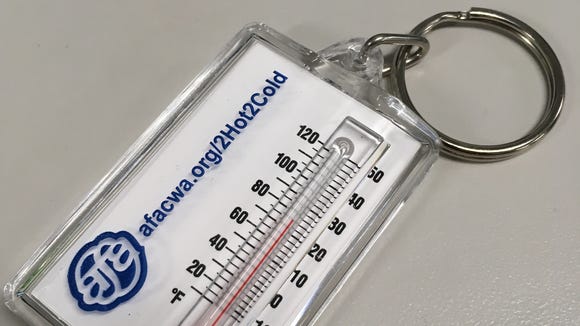Plane too hot? Too cold? Time for DOT to regulate, attendants say
Originally posted by USA TODAY on August 1, 2018.
One of the scariest examples of an overheated airliner came in June 2017, when a woman and her beet-red, 4-month-old baby needed ice bags and then an ambulance because of the heat of a flight in Denver. The child revived with treatment.
But flight attendants’ unions assembled dozens of other anecdotes of planes either too hot or too cold for comfort. With those, the group is urging the Transportation Department to begin regulating the temperature aboard airliners. The union's anecdotes included stories of flight attendants and passengers occasionally passing out or becoming ill aboard hot planes.
“Today there are no standards that exist for aircraft temperatures, for the passengers or the crews that are working those flights,” Sara Nelson, president of the Association of Flight Attendants-CWA, which represents 50,000 workers at 20 airlines, told a news conference Wednesday at Reagan National Airport in Washington. “This is an issue of safety, health and security. If it’s too hot, people can become dizzy, unaware, suffer from heat stroke. If it’s too cold, they can experience cold stress or even hypothermia.”
The department received the petition and is considering it.
The industry group Airlines for America, which represents most of the largest carriers, said regulations are unnecessary because flight attendants work with pilots to adjust each cabin's temperature on a case-by-case basis with the maintenance teams at each airline.
"The safety and well-being of our passengers and crew is the industry’s No. 1 priority," said Alison McAfee, a spokeswoman for the airline group. "U.S. airlines work hard to maintain a level of comfort passengers expect on each and every flight, including the temperature of the cabin."
The only temperature regulation now requires the cabin temperature to be within 5 degrees of the cockpit. But it doesn’t set minimums or maximums.

An example of keychain thermometers the Association of Flight Attendants-CWA is distributing starting Aug. 1, 2018, to 60,000 flight attendants in an effort to document extreme temperatures aboard airlines for the DOT. (Photo: Bart Jansen, USA TODAY)
The department can potentially fine an airline for lengthy tarmac delays of three hours for domestic flights and four hours for international flights. But planes can heat up faster than that. A Federal Aviation Administration advisory recommends letting passengers off planes if there is no ventilation for 30 minutes.
The industry consensus from unions, airlines, manufacturers and airports is that an acceptable temperature aboard a plane is 65 to 75 degrees, and up to 85 degrees if all entertainment units are functioning, according to Nelson. Strategies to keep a plane cool on the ground include closing the window shades and filtering in cooler air from the jetway.
But problems can arise with the auxiliary power units aboard planes on the ground and the ground-based air conditioning that airlines and airports can provide.
To gather data, unions are distributing 60,000 thermometers during August for flight attendants to report uncomfortable temperatures that will be shared with the department. The unions also have created an app called 2Hot2Cold for passengers to report extreme temperatures, and collected thousands of reports already.
“Extreme cabin temperature while boarding and working on an aircraft inhibit a flight attendant’s No. 1 responsibility: the safety and security of passengers,” said Lyn Montgomery, president of Transport Workers Union Local 556, which represents 20,000 flight attendants at Southwest Airlines, JetBlue Airways and Allegiant Air.
Southwest flight attendants can already report warm cabin temperatures via their iPads, with the date, city, flight number, time of day and locations on the plane that were warmest. The airline's technical operations team then reviews the information, and possibly checks the plane.
Southwest noted that it serves 99 U.S. destinations with varying climates and temperatures, pilots and flight attendants are authorized to adjust cabin temperature through the auxiliary power unit aboard the plane or air-conditioning units at airports.
The unions' petition submitted July 2 gathered anonymous reports from crew members that are submitted to NASA and to the unions. Those anonymous reports included:
-- In June 2018, a flight attendant reported temperature above 88 degrees in a plane stuck on the ground for more than two hours with the door open: “I felt as though we were all being held hostage.”
-- In July 2017, a passenger collapsed in the galley of a hot plane and he was taken away by ambulance. Seven more people sought medical care at the gate.
-- In August 2014, a flight attendant on an MD-80-type plane reported “sweating profusely” and passing out in a jump seat because an auxiliary power unit wasn’t working to cool the plane: “I was hot, dizzy, confused and then blacked out.”
-- In July 2014, the captain of a CRJ-900 reported the temperature in the cockpit rarely went below 90 degrees during three flights in one day.
-- In September 2013, one flight attendant felt ill and another began vomiting because of “very hot” temperatures during three flights in one day.
Greg Regan, secretary-treasurer of the Transportation Trades Department of AFL-CIO, said extreme temperatures can divert flights and force passengers to change planes, which causes flight disruptions to ripple across the country.
“Incidents where an infant is hospitalized or a passenger or a crew member becomes seriously ill should spur government action to ensure that these events never happen again,” Regan said.


